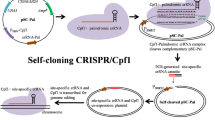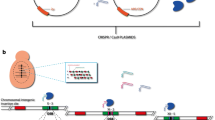Abstract
A method called Cas-3P allowing for immediate, multiplexed and sequential genome engineering was developed using one plasmid expressing Cas9 and three marked plasmid backbones (P1, P2 and P3) for guide RNA (gRNA) expression. The three marked gRNA plasmid backbones were recurred in a P1–P2–P3 order for sequential gene targeting, without construction of any additional plasmid and elimination of gRNA plasmid by induction in each round. The efficiency of direct gRNA plasmid curing mediated by Cas-3P was more than 40% in sequential gene targeting. Besides, Cas-3P allowed single-, double- and triple-loci gene targeting with an efficiency of 75%, 36.8% and 8.2% within 3–4 days, respectively. Through three sequential rounds of gene targeting within 10 days, S. cerevisiae was optimized for the production of patchoulol by replacing one promoter, overexpressing three genes and disrupting four genes. The work is important for practical application in the cell factory engineering of S. cerevisiae.






Similar content being viewed by others
References
Albertsen L, Chen Y, Bach LS, Rattleff S, Maury J, Brix S, Nielsen J, Mortensen UH (2011) Diversion of flux toward sesquiterpene production in Saccharomyces cerevisiae by fusion of host and heterologous enzymes. Appl Environ Microbiol 77:1033–1040. https://doi.org/10.1128/AEM.01361-10
Altenbuchner J (2016) Editing of the Bacillus subtilis Genome by the CRISPR-Cas9 System. Appl Environ Microbiol 82:5421–5427. https://doi.org/10.1128/AEM.01453-16
Carbonell P, Currin A, Jervis AJ, Rattray NJW, Swainston N, Yan C, Takano E, Breitling R (2016) Bioinformatics for the synthetic biology of natural products: integrating across the Design–Build–Test cycle. Nat Prod Rep 33:925
Casini A, Christodoulou G, Freemont PS, Baldwin GS, Ellis T, MacDonald JT (2014) R2oDNA designer: computational design of biologically neutral synthetic DNA sequences. Acs Synth Biol 3:525–528. https://doi.org/10.1021/sb4001323
Chee MK, Haase SB (2012) New and redesigned pRS plasmid shuttle vectors for genetic manipulation of Saccharomyces cerevisiae. G3-GENES GENOM GENET 2:515–526. https://doi.org/10.1534/g3.111.001917
Chung ME, Yeh IH, Sung LY, Wu MY, Chao YP, Ng IS, Hu YC (2017) Enhanced integration of large DNA into E. coli chromosome by CRISPR/Cas9. Biotechnol Bioeng 114:172–183. https://doi.org/10.1002/bit.26056
Dai Z, Wang B, Liu Y, Shi M, Wang D, Zhang X, Liu T, Huang L, Zhang X (2014) Producing aglycons of ginsenosides in bakers’ yeast. Sci Rep 4:3698. https://doi.org/10.1038/srep03698
Designer deletion strains derived from Saccharomyces cerevisiae S288C A useful set of strains and plasmids for PCR-mediated gene disruption and other applications. (2010) Yeast 14:115–132
DiCarlo JE, Norville JE, Mali P, Rios X, Aach J, Church GM (2013) Genome engineering in Saccharomyces cerevisiae using CRISPR-Cas systems. Nucleic Acids Res 41:4336–4343. https://doi.org/10.1093/nar/gkt135
Ro DK, Paradise EM, Ouellet M, Fisher KJ, Newman KL, Ndungu JM, Ho KA, Eachus RA, Ham TS, Kirby J, Chang MC, Withers ST, Shiba Y, Sarpong R, Keasling JD (2006) Production of the antimalarial drug precursor artemisinic acid in engineered yeast. Nature 440:940
Engels B, Dahm P, Jennewein S (2008) Metabolic engineering of taxadiene biosynthesis in yeast as a first step towards taxol (paclitaxel) production. Metab Eng 10:201–206. https://doi.org/10.1016/j.ymben.2008.03.001
Gueldener U, Heinisch J, Koehler GJ, Voss D, Hegemann JH (2002) A second set of loxP marker cassettes for Cre-mediated multiple gene knockouts in budding yeast. Nucleic Acids Res 30:23. https://doi.org/10.1093/nar/30.6.e23
Horwitz A, Walter J, Schubert M, Kung S, Hawkins K, Platt D, Hernday A, Mahatdejkul-Meadows T, Szeto W, Chandran S (2015) Efficient Multiplexed Integration of Synergistic Alleles and Metabolic Pathways in Yeasts via CRISPR-Cas Cell Sys 1:88–96
Hu H, Wang T, Chen J, Yu F, Liu H, Zuo Z, Yang Z, Fan H (2016) Screening and identification of proteins interacting with IL-24 by the yeast two-hybrid screen, Co-IP, and FRET assays. Anticancer Drugs 27:318–327. https://doi.org/10.1097/CAD.0000000000000343
Hwang WY, Fu YF, Reyon D, Maeder ML, Tsai SQ, Sander JD, Peterson RT, Yeh JRJ, Joung JK (2013) Efficient genome editing in zebrafish using a CRISPR-Cas system. Nat Biotechnol 31:227–229. https://doi.org/10.1038/nbt.2501
Jakociunas T, Rajkumar AS, Zhang J, Arsovska D, Rodriguez A, Jendresen CB, Skjodt ML, Nielsen AT, Borodina I, Jensen MK, Keasling JD (2015) CasEMBLR: Cas9-Facilitated Multiloci Genomic Integration of in Vivo Assembled DNA Parts in Saccharomyces cerevisiae. Acs Synth Biol 4:1226–1234. https://doi.org/10.1021/acssynbio.5b00007
Kawai S, Hashimoto W, Murata K (2010) Transformation of Saccharomyces cerevisiae and other fungi: methods and possible underlying mechanism. Bioeng Bugs 1:395–403. https://doi.org/10.4161/bbug.1.6.13257
Kondo T, Tezuka H, Ishii J, Matsuda F, Ogino C, Kondo A (2012) Genetic engineering to enhance the Ehrlich pathway and alter carbon flux for increased isobutanol production from glucose by Saccharomyces cerevisiae. J Biotechnol 159:32–37. https://doi.org/10.1016/j.jbiotec.2012.01.022
Mali P, Yang L, Esvelt KM, Aach J, Guell M, DiCarlo JE, Norville JE, Church GM (2013) RNA-guided human genome engineering via Cas9. Science 339:823–826. https://doi.org/10.1126/science.1232033
Marienhagen J, Bott M (2013) Metabolic engineering of microorganisms for the synthesis of plant natural products. J Biotechnol 163:166–178. https://doi.org/10.1016/j.jbiotec.2012.06.001
Meadows AL, Hawkins KM, Tsegaye Y, Antipov E, Kim Y, Raetz L, Dahl RH, Tai A, Mahatdejkul-Meadows T, Xu L, Zhao L, Dasika MS, Murarka A, Lenihan J, Eng D, Leng JS, Liu CL, Wenger JW, Jiang H, Chao L, Westfall P, Lai J, Ganesan S, Jackson P, Mans R, Platt D, Reeves CD, Saija PR, Wichmann G, Holmes VF, Benjamin K, Hill PW, Gardner TS, Tsong AE (2016) Rewriting yeast central carbon metabolism for industrial isoprenoid production. Nature 537:694–697. https://doi.org/10.1038/nature19769
Nielsen J, Keasling JD (2016) Engineering Cellular Metabolism. Cell 164:1185–1197
Paddon CJ, Keasling JD (2014) Semi-synthetic artemisinin: a model for the use of synthetic biology in pharmaceutical development. Nat Rev Microbiol 12:355–367. https://doi.org/10.1038/nrmicro3240
Sander JD, Joung JK (2014) CRISPR-Cas systems for editing, regulating and targeting genomes. Nat Biotechnol 32:347–355. https://doi.org/10.1038/nbt.2842
Schwartz C, Shabbir-Hussain M, Frogue K, Blenner M, Wheeldon I (2017) Standardized markerless gene integration for pathway engineering in Yarrowia lipolytica. Acs Synth Biol 6:402–409. https://doi.org/10.1021/acssynbio.6b00285
Siddiqui MS, Choksi A, Smolke CD (2015) A system for multi-locus chromosomal integration and transformation-free selection marker rescue. FEMS Yeast Res 14:1171–1185
Smanski MJ, Bhatia S, Zhao D, Park Y, Woodruff LB, Giannoukos G, Ciulla D, Busby M, Calderon J, Nicol R, Gordon DB, Densmore D, Voigt CA (2014) Functional optimization of gene clusters by combinatorial design and assembly. Nat Biotechnol 32:1241–1249
Song X, Huang H, Xiong ZQ, Ai LZ, Yang S (2017) CRISPR-Cas 9(D10A) Nickase-Assisted Genome Editing in Lactobacillus casei. Appl Environ Microb 83:1259–1267. https://doi.org/10.1128/AEM.01259-17
Storici F, Durham CL, Gordenin DA, Resnick MA (2003) Chromosomal site-specific double-strand breaks are efficiently targeted for repair by oligonucleotides in yeast. Proc Natl Acad Sci 100:14994–14999. https://doi.org/10.1073/pnas.2036296100
Storici F, Lewis LK, Resnick MA (2001) In vivo site-directed mutagenesis using oligonucleotides. Nat Biotechnol 19:773–776
Wang S, Dong S, Wang P, Tao Y, Wang Y (2017) Genome Editing in Clostridium saccharoperbutylacetonicum N1-4 with the CRISPR-Cas9 System. Appl Environ Microbiol 83:217–233. https://doi.org/10.1128/AEM.00233-17
Westbrook AW, Moo-Young M, Chou CP (2016) Development of a CRISPR-Cas9 tool kit for comprehensive engineering of Bacillus subtilis. Appl Environ Microbiol 82:4876–4895. https://doi.org/10.1128/AEM.01159-16
Wienert B, Wyman SK, Richardson CD, Yeh CD, Akcakaya P, Porritt MJ, Morlock M, Vu JT, Kazane KR, Watry HL, Judge LM, Conklin BR, Maresca M, Corn JE (2019) Unbiased detection of CRISPR off-targets in vivo using DISCOVER-Seq. Science 364:286–289. https://doi.org/10.1126/science.aav9023
Xie W, Liu M, Lv X, Lu W, Gu J, Yu H (2013) Construction of a controllable β-carotene biosynthetic pathway by decentralized assembly strategy in Saccharomyces cerevisiae. Biotechnol Bioeng 111:125–133
Xie W, Ye L, Lv X, Xu H, Yu H (2015) Sequential control of biosynthetic pathways for balanced utilization of metabolic intermediates in Saccharomyces cerevisiae. Metab Eng 28:8–18. https://doi.org/10.1016/j.ymben.2014.11.007
Xu T, Li Y, Shi Z, Hemme CL, Li Y, Zhu Y, Van Nostrand JD, He Z, Zhou J (2015) Efficient Genome Editing in Clostridium cellulolyticum via CRISPR-Cas9 Nickase. Appl Environ Microbiol 81:4423–4431. https://doi.org/10.1128/AEM.00873-15
Jiang Yu, Chen Biao, Duan Chunlan, Sun Bingbing, Yang Junjie, Yang Sheng (2015) Multigene editing in the Escherichia coli genome via the CRISPR-Cas9 system. Appl Environ Microbiol 81:2506–2514
Yao X, Wang X, Hu XD, Liu Z, Liu JL, Zhou HB, Shen XW, Wei Y, Huang ZJ, Ying WQ, Wang Y, Nie YH, Zhang CC, Li SL, Cheng LP, Wang QF, Wu Y, Huang PY, Sun Q, Shi LY, Yang H (2017) Homology-mediated end joining-based targeted integration using CRISPR/Cas9. Cell Res 27:801–814. https://doi.org/10.1038/cr.2017.76
Zetsche B, Gootenberg JS, Abudayyeh OO, Slaymaker IM, Makarova KS, Essletzbichler P, Volz SE, Joung J, van der Oost J, Regev A, Koonin EV, Zhang F (2015) Cpf1 Is a Single RNA-Guided Endonuclease of a Class 2 CRISPR-Cas System. Cell 163:759–771. https://doi.org/10.1016/j.cell.2015.09.038
Zetsche B, Heidenreich M, Mohanraju P, Fedorova I, Kneppers J, Degennaro EM, Winblad N, Choudhury SR, Abudayyeh OO, Gootenberg JS (2017) Multiplex gene editing by CRISPR–Cpf1 using a single crRNA array. Nat Biotechnol 35:31–34
Zhou J, Wu R, Xue X, Qin Z (2016) CasHRA (Cas9-facilitated Homologous Recombination Assembly) method of constructing megabase-sized DNA. Nucleic Acids Res 44:124–133. https://doi.org/10.1093/nar/gkw475
Acknowledgements
This work was financially supported by the National Natural Science Foundation of China (No. 31500043), the Natural Science Foundation of Shanghai (No. 19ZR1473000), the Fundamental Research Funds for the Central Universities (No. 22221818014), and the Open Funding Project of the State Key Laboratory of Bioreactor Engineering.
Author information
Authors and Affiliations
Corresponding authors
Ethics declarations
Conflict of interests
The authors declare that they have no competing interests.
Additional information
Publisher's Note
Springer Nature remains neutral with regard to jurisdictional claims in published maps and institutional affiliations.
Electronic supplementary material
Below is the link to the electronic supplementary material.
Rights and permissions
About this article
Cite this article
Li, ZH., Meng, H., Ma, B. et al. Immediate, multiplexed and sequential genome engineering facilitated by CRISPR/Cas9 in Saccharomyces cerevisiae. J Ind Microbiol Biotechnol 47, 83–96 (2020). https://doi.org/10.1007/s10295-019-02251-w
Received:
Accepted:
Published:
Issue Date:
DOI: https://doi.org/10.1007/s10295-019-02251-w




